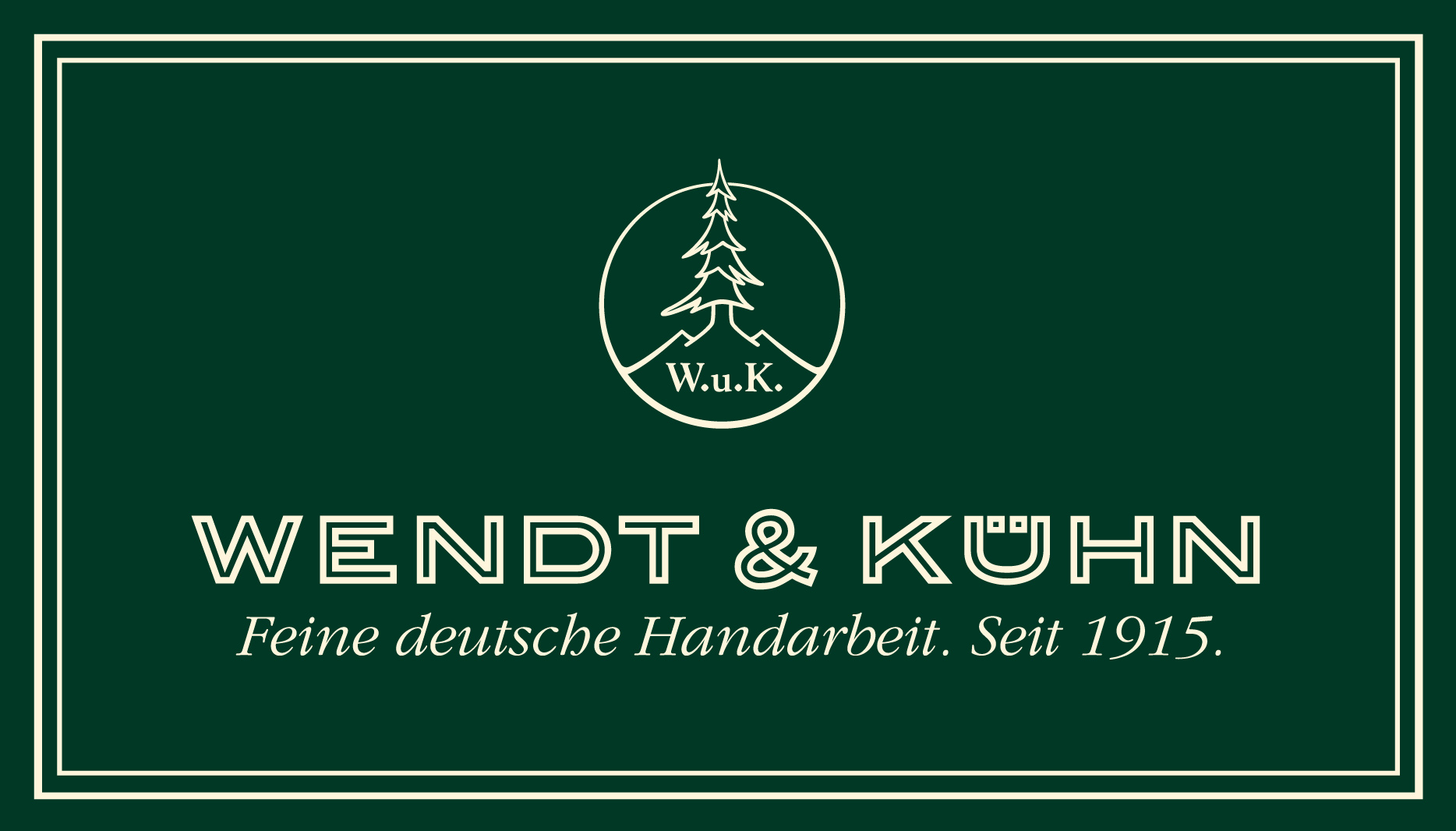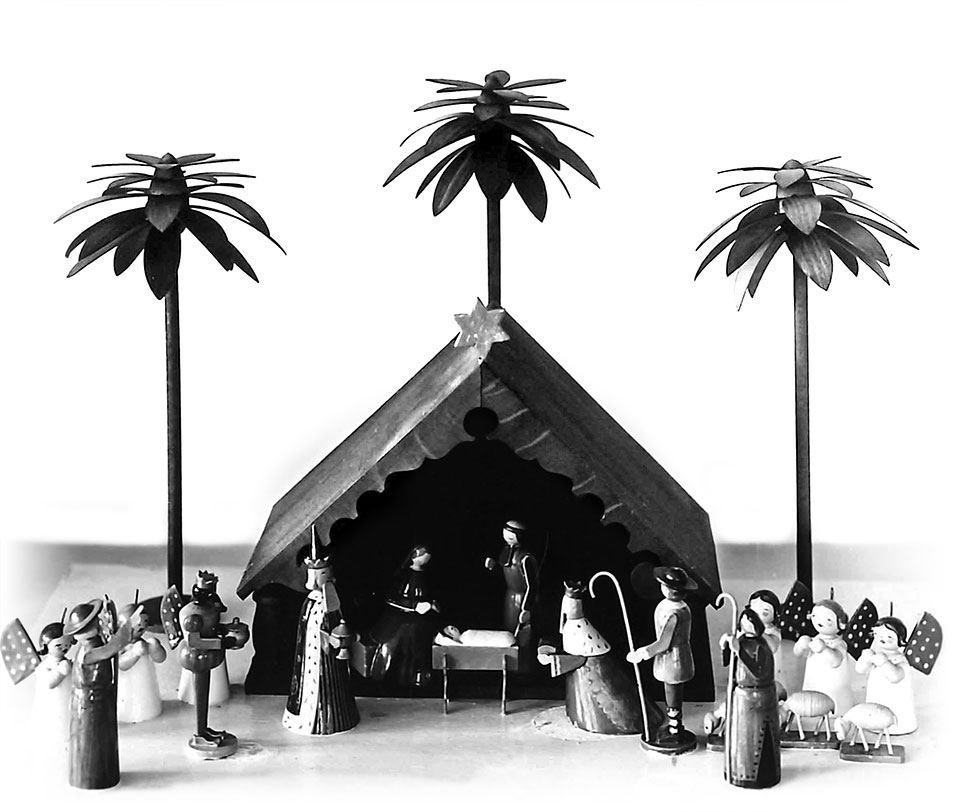
Grete Wendt was an observer of life, she travelled throughout Europe and created scores of figurines – above all, her angels with their characteristic green wings and eleven white dots. When in 1937 she received a gold medal at the World Exhibition in Paris for the design of her figurines, there was no stopping the international victory march of these angel musicians. Perhaps at the time she already knew that what is sometimes impossible for human beings can be accomplished by the power of angels.
The Beginnings
On February 24, 1887, a little girl was born in Grünhainichen who would one day change the world and become known as the creator of the Eleven Dot Angels. Her parents baptized her Margarete. The daughter of Albert Wendt, a teacher at the vocational school in Grünhainichen, Margarete, known as Grete, loved building and crafting, drawing and painting from a very early age. Later she accompanied her father to school, where at the time only boys were taught – the start of the emancipation of a girl who as a young woman would have the courage to found a company, keep it going for decades and ensure that it later passed into the safe hands of family members. (Matthias Zwarg, 2019*)
It must have been a wonderful time for a young woman to arrive in the metropolis of Dresden from provincial Grünhainichen. 1907 was an important year for the state capital of Saxony. Not because the local history records note the founding of the Association for German Women’s Clothing, which immediately had to address itself to designs for “sensible school and gymnastics clothing in girls’ schools”. Nor because of the construction of the new Augustus Bridge and the building of the Yenidze cigarette factory, nor even because the federal government declared the Saxon wine-growing region to be “irreparably contaminated”. No, much more important was that on November 1st a law on the rights of women to study came into force, meaning that from 1908 women were allowed to attend universities and technical colleges.
Shortly before this, the Royal Saxon Academy of Applied Arts in Dresden opened its first class for women, which Grete entered in January 1907. Like many of her fellow students and her later company co-founder Grete Kühn, she had already received some artistic training. It was an exciting time.
Both young women had attended the private drawing school run by the Kleinhempel siblings in Dresden for three years. Gertrud, Erich and Fritz Kleinhempel were all closely involved in the reform movement of the time, which defended artisanal traditions against the rapid advance of emerging mass-produced industrial products, and which boldly borrowed from the past. (Matthias Zwarg, 2019*)
The beginning of a design story
The final stage of Grete Wendt’s course was a practical semester, which she completed at the Deutsche Werkstätten in Hellerau, now a district of Dresden. The company was a modern, aspiring enterprise. A part of the Arts and Crafts reform movement, it was considered to be one of the most important manufacturers of furniture designed by well-known artists. Laid out like an estate, the factory halls and their modern architecture must have made quite an impression on Grete Wendt when, in October 1910, she arrived to start her internship. Karl Schmidt, the founder of the Werkstätten, gave her her first commission – to design a nativity scene. Her design was manufactured externally by the company Th. Heymann in Großolbersdorf, as at the time Grete Wendt had no workshop of her own. In 1911, shortly after she had designed the nativity set and the first samples had been made, the talented young designer exhibited it at the Christmas exhibition of the King Albert Museum in Chemnitz (today the Kunstsammlungen Chemnitz). During the two-week exhibition her nativity scene attracted much attention from visitors. While the exhibition was still going on, Grete Wendt received a request from the Dürerbund in Dresden to include her nativity scene in the product range of the Dresden Dürerhaus. At the time the Dürerbund was the leading organisation for cultural reform in the German-speaking world. Even more prestigious for the young designer was the fact that the request came directly from Ferdinand Avenarius, the founder of the Dürerbund. At the same time many specialist magazines and daily newspapers reported on the exhibition and they always mentioned the successful design by Grete Wendt from Grünhainichen. Discover more about the design history of the nativity scene.
The breakthrough
In 1913, Grete Wendt entered her design the “Berry Pickers” in a competition organized by the Sächsischer Heimatschutz to create good travel souvenirs. She won many awards for this and the orders came flooding in. The first examples were at this time still made in her parents’ apartment, by specially commissioned toy makers.
The desire to start her own company grew and grew. And on October 1, 1915 she founded the partnership “M. Wendt u. M. Kühn” together with her college friend Margarete Kühn. Following Grete Kühn’s marriage, Grete Wendt became the sole owner of the workshops, as the two friends had already agreed. At that time a wife’s property automatically passed to her husband. The agreement between the two friends guaranteed that the company would remain in the hands of the two founders, or at least one of them.
Until 1972, when the workshops were compulsorily nationalized, Grete Wendt managed the fortunes of the company herself, she travelled to many countries to present her designs at well-known trade fairs and she never stopped designing figurines.
Artistic achievement
Grete Wendt succeeded in assembling wooden components in such a way that her figurines come to life, appear to move and radiate joie de vivre. This is all down to Grete’s special technique of creating the figurative composition only once the turned, shaped and sanded wooden components have been fitted together. At the Paris World Exhibition in 1937,
Grete was to gain international recognition with her Angel Mountain with Madonna for this particular manufacturing process and the resulting figurines it produced. It was the combination of her own individual artistic style and traditional Erzgebirge woodworking craftsmanship, together with her many exquisite designs that established the success of the young company and allows it still to endure to this day.
Between heaven and earth
Grete’s Grünhainichen Angels® are what still thrill a large number of fans around the world today. The colorful Blossom Kinder are also very popular. So you could say that the Blossom Kinder, with their “proximity to the earth”, and the angels, who enjoy the privilege of being able to ascend to the heavens, are both able to touch people’s hearts. Spatially they may be far apart, even though from time to time an angel is sure to descend to earth to check on things. But it is perhaps this apparent contrast that gives Grete’s wide range of designs their magic – being grounded on the one hand and on the other having also the ability to give ideas free reign, to be confident and to give this same confidence to every angel who finds a new home to carry with them.
With their over-sized flowers, the Blossom Kinder draw our gaze to what are otherwise relatively small things. Great attention to detail, craftsmanship and skill are required to figuratively depict the lightness of childhood with the delicate beauty of nature.
On July 1, 1979 Grete Wendt died in Grünhainichen, the small town that had been her home all her life and which she had made famous through her designs. And even though Grete’s death now lies far in the past, her legacy still survives and can be experienced today – in the company’s historic premises, in the Grand Sample Cabinet and in the workshops where craftsmen and women keep Grete’s designs and fine craftsmanship alive.
“Only when you do something with love will it also return love.”
*Matthias Zwarg is the author of the 2019 limited edition book “Geschichten aus der Manufaktur” (Stories from the Manufactory), which was published to mark its 100th anniversary and contains stories and highlights from 100 years of company history. The book is now out of print. If you wish to learn more about the history of the workshops, you can gain fascinating insights by visiting the informative special exhibitions and interactive area at Wendt & Kühn World. We also regularly publish interesting facts and historical photos in our eleven dot post and on our Instagram account.

![[Translate to Englisch (Intl):] Grete mit den Brüdern Curt und Johannes [Translate to Englisch (Intl):] Schwarz-Weiß-Aufnahme. Grete im dunklen Kleid und mit Puppe im Arm neben ihren Brüdern. Curt im Anzug, Johannes als kleiner Junge im Ringelpullover.](/fileadmin/media/wk/bilder_seitengestaltung/Detailseite_Olly/Grete_Kind.jpg)
![[Translate to Englisch (Intl):] Grete Wendt (links) in der Gewerbeschule in Grünhainichen [Translate to Englisch (Intl):] Historische Aufnahme. Klassenfoto aus der Gewerbeschule. Grete Wendt als einziges Mädchen in der Klasse. Aufnahme im Winter, die Kinder sind in Mäntel und Mützen gekleidet. Es liegt Schnee.](/fileadmin/_processed_/f/e/csm_Grete_Klasse_GH_ea65f7a84f.jpg)

![[Translate to Englisch (Intl):] Historische Skizze [Translate to Englisch (Intl):] Skizze von der Beerensammlergruppe. 3 Figuren in verschiedenen Perspektiven. Bleistiftzeichnung.](/fileadmin/media/wk/bilder_seitengestaltung/Detailseite_Olly/Beerensammler_Skizze.jpg)
![[Translate to Englisch (Intl):] Engelorchester mit Madonna [Translate to Englisch (Intl):] Schwarz-Weiß-Aufnahme vom Engelorchester mit Madonna auf einem Engelberg. Auf den unteren Stufen die Engelmusikanten. An oberster Stelle die Madonna mit Schleier und im langen Kleid. Im Hintergrund Kerzen.](/fileadmin/media/wk/bilder_seitengestaltung/Detailseite_Olly/Engelberg_Madonna.jpg)
![[Translate to Englisch (Intl):] Grete Wendt im Jahr 1973 [Translate to Englisch (Intl):] Grete Wendt im braunen Mantel und mit Mütze mit einem bunten Blumenstrauß in der Hand. Sie steht in einem sonst herbstlichen Garten.](/fileadmin/media/wk/bilder_seitengestaltung/Detailseite_Olly/Grete_1973.jpg)